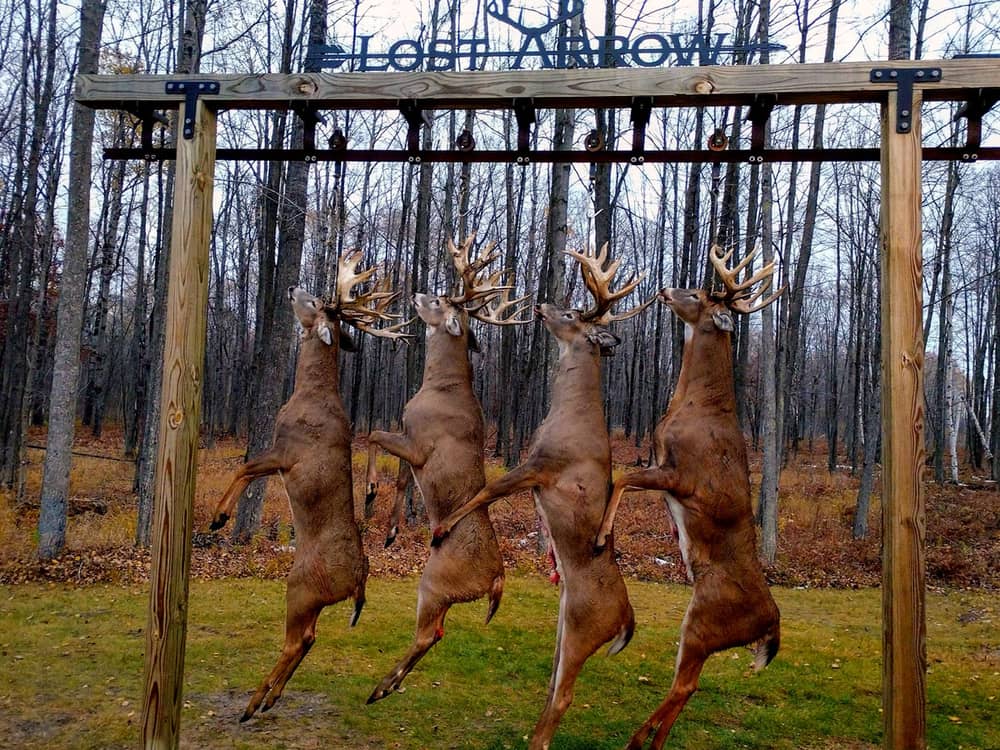Deer hanging poles, also known as gambrels or game hoists, are crucial hunting tools. This article will provide efficient deer hanging pole ideas and practical solutions for safely and successfully.
The notion of deer hanging poles has developed over time, with many ideas and designs arising to meet the diverse needs of hunters. The possibilities for deer hanging poles are numerous. It ranges from simple and portable solutions made of solid materials to more complicated installations with adjustable heights and additional capabilities.
These suggestions attempt to improve convenience, durability, and versatility. Hunters can manage deer carcasses effectively in the field or at home. Whether for lone or group hunters, the perfect deer hanging pole idea can greatly simplify the task. It also assures optimal cleanliness and resource utilization.
Table of Contents
What Are Common Hanging Pole Ideas?
Deer hanging pole ideas include a variety of creative concepts and designs. They contribute to the functionality, mobility, and ease of use of suspending deer carcasses. Here are several common deer hanging pole designs:
Portable Tripod Design
This concept entails a collapsible tripod construction composed of lightweight yet durable materials such as aluminum or steel. It is simple to assemble and move. When moving or having limited storage space, hunters might employ this design.
Adjustable Height Feature
Some deer hanging poles are telescopic or adjustable in height. This allows hunters to adjust the corpse to a more comfortable working height, decreasing strain during field dressing.
Multiple Hooks
These poles have many hooks or gambrels attached to the main support arm rather than a single hook. This design allows hunters to hang many deer at the same time, reducing processing time.
Integrated Scale
Certain deer hanging poles have built-in scales that allow hunters to weigh the animal as it is hanged. This eliminates the need for separate weighing equipment and makes harvest weights easy to track.
Quick Assembly Systems
These concepts center on a simple, quick-assembly system, such as snap-lock mechanisms or quick-release clamps. They allow hunters to quickly put up and dismantle the hanging pole, saving time in the field.
All-Terrain Base
Some deer hanging poles include a strong, wide-base design, as well as additional attachments such as spiked feet or ground anchors. This provides stability on a variety of terrains, including uneven or spongy surfaces.
Multi-purpose Functionality
Certain hanging poles are designed to serve various functions. You can use it as a shooting rest or tripod for spotting scopes or cameras. These adaptable designs bring value and utility for hunters.
Hunters can select the greatest deer hanging pole idea based on their personal preferences and special hunting demands.
Materials You Need To Prepare

A few basic components are required to construct a deer hanging pole. The following are the materials needed to build a functional and robust deer hanging pole:
Metal Pipe
Choose a long, durable metal pipe, such as galvanized steel or aluminum, with a length of 8 to 10 feet. This pipe will be the major support structure for the hanging pole.
T-joint Fitting in Metal
This fitting is required to make the deer hanging pole’s top support arm. It must be suitable with the diameter of the metal pipe that you select.
Metal Elbow Joint Fitting
The elbow joint fitting joins to the opposite end of the metal pipe, forming a perpendicular arm from which the deer corpse will hang. Check that it matches the diameter of the pipe.
Metal Chain or Heavy-Duty Rope
This will be utilized to suspend the deer carcass from the hanging pole. Choose a strong and dependable metal chain or heavy-duty rope that can withstand the animal’s weight.
Carabiner or S-Hook
This is essential to securely attach the chain or rope to the hanging pole. Check if it is robust and durable enough to handle the load.
Adjustable Wrench or Pipe Wrench
These tools are required for tightening and securing the fittings to the metal pipe.
Measuring Tape
A measuring tape will be required to establish the desired length for your hanging pole and ensure precision during assembly.
Safety Gear
When working with tools and materials, always put safety first. Wear safety goggles to protect your eyes and gloves to protect your hands.
How To Make Deer Hanging Poles?
Making a deer hanging pole is a simple operation that involves only a few materials and basic tools. Here’s how to create a basic and practical deer hanging pole step by step:
Measure And Cut The Metal Pipe
Determine the length of your hanging pole with a measuring tape. Using a hacksaw or pipe cutter, cut the metal pipe to the necessary size.
Attach The Fittings
Attach the top end of the metal pipe to the metal T-joint fitting. This will serve as the auxiliary arm. To create a perpendicular arm, attach the metal elbow joint fitting to the pipe’s opposite end.
Secure The Chain Or Rope
Drill a hole at the elbow joint fitting if necessary, and secure the metal chain or heavy-duty rope with a carabiner or S-hook. Assemble it tightly to hold the weight of the deer carcass.
Adjust And Test
Before using the deer hanging pole, check its stability and strength. Adjust or fortify it as needed to maintain its stability and safety.
Wear safety goggles and gloves during the construction process to prioritize safety. In addition, if you are unsure about any process, get advice from experienced hunters or specialists. You must guarantee that the deer hanging pole is properly installed and used.
Final Thoughts
In conclusion, deer hanging pole concepts contribute to the efficiency and ease of hung deer carcasses during field dressing and processing. By following these suggestions, hunters can improve the safety and enjoyment of their processing procedures. We hope you found this post useful.

